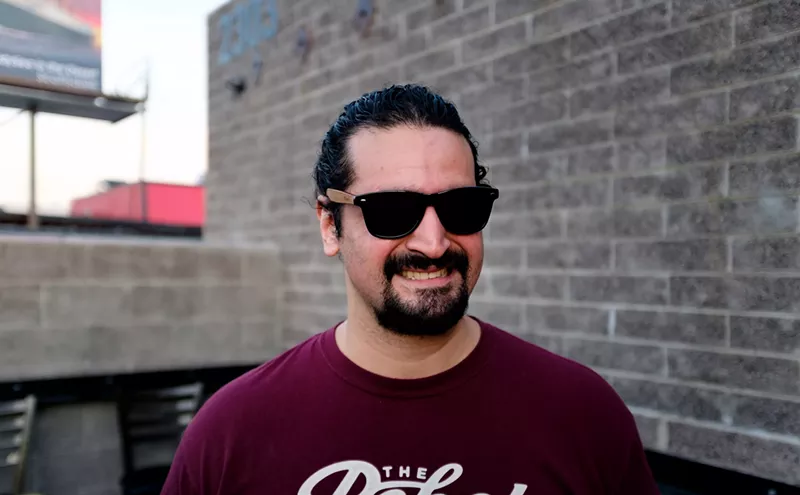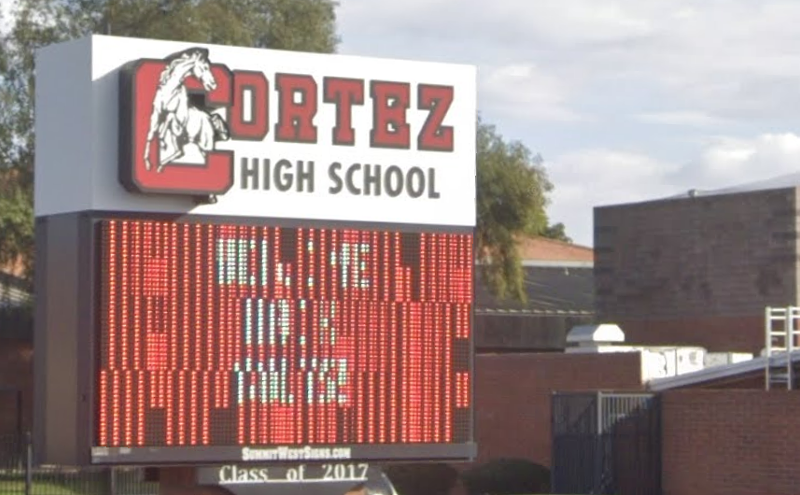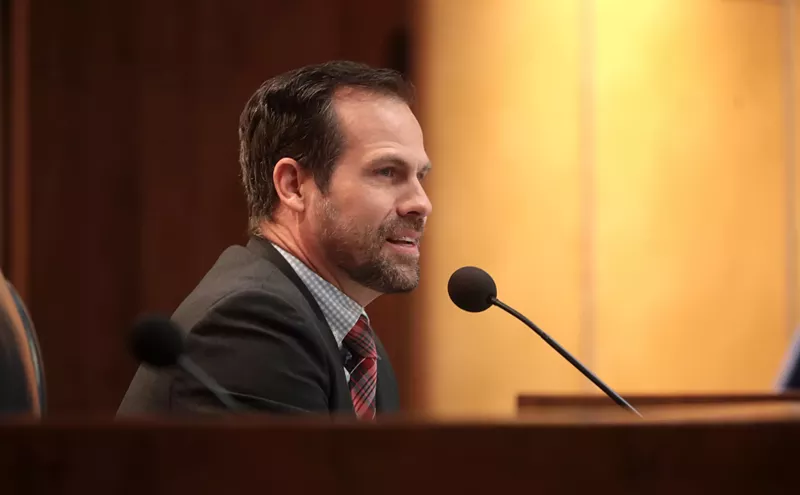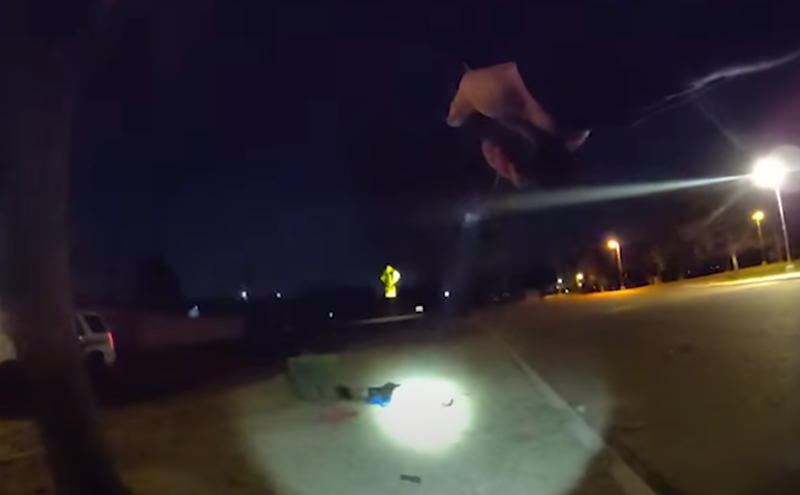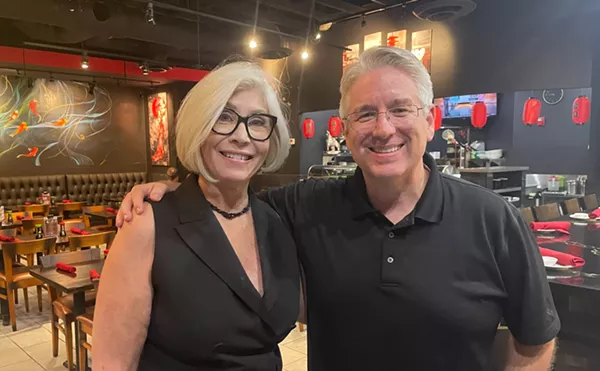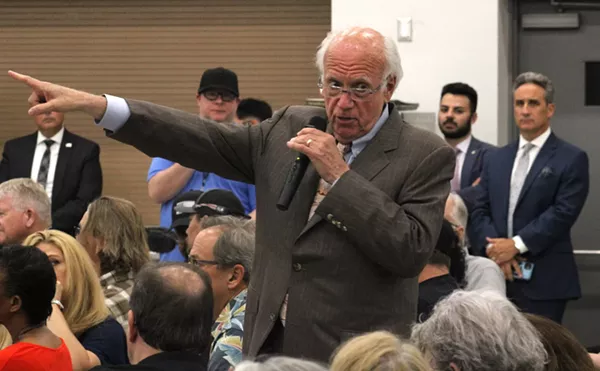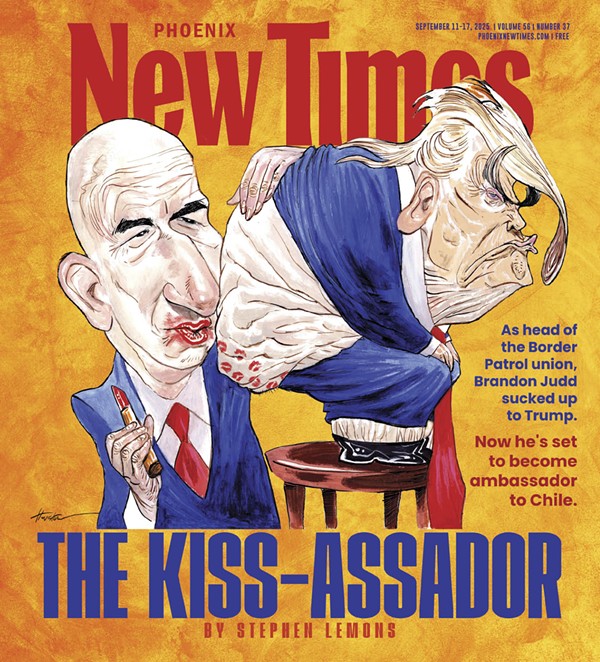I have lived in Arizona for 32 years and never hiked to the bottom of the canyon, let alone rim-to-rim. Now was the time — in the dead of summer, when the sun would control.
I wanted this to be a transformational experience for my sons, Jed, 20, and Joey, 16, and a confirmational experience for myself — that I still had it in me at age 50. My oldest friend, Jeff Hansen, also at the half-century mark, joined us.
Down the steep pathway we ventured, with the San Francisco Peaks lurking above the horizon as a sentinel above the gorge below. We were about to enter into a realm that would propel us into different dimensions.
I will not venture to speak for my companions, for such experiences are intensely personal.
But for myself, I will share with you a glimpse of what happened and why now I am sitting in a bar adjacent to the downtown square of Arcata, California, eating a pizza with anchovies while Pink Floyd's The Dark Side of the Moon plays on the Internet jukebox, and, most important, writing my last column for this rag.
The canyon is seductive, like a beautiful mistress beaconing across the darkest night. You think you have it made, and then karma's knife plows deep into your heart, leaving you gasping.
And then you know, the only option is to take it one step at a time.
Twenty-two years ago, I set off from my parents' home in northern Virginia with my backpack, my dog Bear and a new pair of hiking boots. I already was fed up with the corruption and deceit that permeated Washington, D.C.
I longed for the West, whose raw beauty had stolen my heart as a college student at Arizona State University in the 1970s.
But I was also a child of the nation's capital. I was on Constitution Avenue in November 1963 and saw President John F. Kennedy's horse-drawn casket roll by accompanied by the drummers' mournful beat that still occasionally resonates in my mind.
I was raised in the flotsam of Vietnam and the constitutional crisis spawned by Watergate, a time when great journalism turned the tide — however briefly.
I was inspired by the power of the press.
After graduating from ASU in 1978, I worked as a copy boy at the Washington Post. I met Bob Woodward. I met Ben Bradlee. I worked in the newsroom of the greatest newspaper in the world covering high school sports and inconsequential business stories. I flashed my Washington Post ID badge at the building security guard with pride.
But there was no full-time staff writer slot to be had. I was told to go out into the hinterlands and practice the art. So I did.
I dropped off my new Chevy Chevette at the car dealership in Arlington, Virginia, with a note saying something to the effect that I didn't want the thing anymore and they could take it back.
I watched my mother's mouth drop as I entered the kitchen — head shaved — on a clear April morning in 1984 and said I was heading to the Grand Tetons of Wyoming and that I'd be back sometime.
Bear and I walked down to Interstate 66, and we set forth on a trek to find out what's up. An Australian shepherd-golden retriever mix, Bear was happiest when we were moving. And what made Bear happy made me happy.
Rides came quick.
Rides came slow.
I fell into that rare space in life when time was plentiful and cash was short. All I needed was a warm sleeping bag and a good dog to survive.
A week later, we were in Denver, where a huge snowstorm blocked our path to the Tetons. The decision on where to go next was easy: Arizona.
We landed at the Farmer House, a hippie pad in old Tempe, where travelers came and went like the wind. I started working with a couple of block-layer buddies as their bitch, mixing and hauling cement up to the masters as they laid up another wall.
Grace soon intervened, and I somehow landed a job as a business reporter (of all things) at the Phoenix Gazette covering agriculture. Yeah, I had degrees in journalism and economics, but didn't know wheat from alfalfa. I quickly discovered that farming needs water, and, in Arizona, water is king.
I suddenly had a grand high perch overlooking Arizona politics. What a cesspool I saw!
There was only one option: I wanted to discover if there was anything, something, a strand, a morsel, a pebble of truth that I could grab onto and try to turn the tide a bit.
Just a tiny bit.
The air was cool and the going was easy down the steep slopes of the North Rim. We arrived at Cottonwood Canyon by 10 a.m., the spot where I had reserved a campsite for the night. My sons were pumped — they wanted to keep going another seven miles to Phantom Ranch and the Bright Angel Campground.
Jeff and I were also infected with youthful vigor, having arrived at the resting point much sooner than expected. We kicked back for a few moments, refilled our water jugs and set off into the heart of the canyon in the heat of the day.
"This is when people get into trouble," Jeff said while we sipped some water mixed with Gatorade.
But his words did not discourage any of us from putting on our packs and moving on.
The deeper we pressed, the higher and narrower the canyon walls loomed above us. We were walking dead into a furnace known as The Box. It was July 21, and the temperature was climbing upward of 110.
My sons — attached at the hip as they have always been — took off on a rapid march to reach Phantom Ranch as the heat steadily increased. Jeff and I brought up the rear. Jeff began to stagger under the weight of his heavy pack. I started looking at the creek that was separated from us by a steep embankment, hoping to find an easy path to her shore.
We hiked from one shady spot to the next, silently wondering just how much farther was the security of Phantom Ranch. No one else was on the trail; it was late July, and only desert rats such as ourselves would dare to knowingly venture into such an inferno at midday.
We were creeping close to the edge — close enough to invigorate the soul. We paused to measure the water left in the jug and to carefully monitor the sweat on our brows.
Finally, we saw a pathway cut down the bank and we skirted down to Bright Angel Creek, stripped off our shirts and dunked them into the water. Putting the shirt back on, I shivered as the cold water seeped from the cotton and cooled my spine.
I knew we would make the next two miles.
I could only assume the kids were way ahead of us.
I had to let them go.
The Phoenix Gazette epitomized everything that was wrong with American journalism. The afternoon daily was gutless, pointless. But I lurched ahead anyway — reporting in the mid-1980s about how scores of migrant workers were dying in the desert trying to get to a large ranch owned by what was then the state's biggest bank — Valley National.
I even had a business column, briefly.
In my third effort, I wrote how more than 88 percent of the water in Arizona is used by agriculture and that the widespread perception that there was a water shortage was a mirage perpetrated by development interests intent on turning the desert into suburban hell.
That was my last column, as the managing editor was not about to allow some wild-eyed punk upset the status quo by revealing the secret to Arizona's rampaging growth machine.
I bolted from the Gazette, taking a $13,000-a-year pay cut to join the East Valley Tribune in Mesa, thinking I could get some decent clips under the direction of my former ASU journalism professor, the now-deceased Max Jennings.
I was lucky because the mother of my children, Barbara, never flinched at such a decision that did not make a bit of financial sense for our young family.
Mesa soon led us to Ohio, where I rejoined Jennings, who had become editor of the Dayton Daily News. I landed on the business desk covering banking and the automobile industry under the editorial direction of the great Jon Talton, now a columnist with the Arizona Republic.
Talton asked me to ferret out the mess created in Arizona by Charles Keating — who hailed from Cincinnati, where the daily newspaper was giving him a free ride. I soon found myself interviewing Edwin Gray, former head of the Federal Savings and Loan Insurance Corporation.
Gray told me about his meeting with five senators who had tried to get him to go easy on Keating's bank, Lincoln Savings and Loan. I wrote a Sunday front-page story for the Dayton Daily News that was the lead story on CBS News two nights later. Before long, the Senate Ethics Committee was investigating what became known as the Keating Five — then the biggest scandal in Congress since Reconstruction. Gray credited my story as the primary reason for the investigation.
I had hit a home run, and the Dayton Daily News, a dismal daily controlled by a shortsighted union, gave me a $15-a-week raise. I could not have cared less. Once again, the West pulled at us.
We bolted for Half Moon Bay, California, to join my old friend and former Gazette assistant city editor Jeremy Voas, where I would learn the art of putting out a weekly community newspaper — the toughest job in American journalism.
We reached Phantom Ranch to find the boys sitting underneath a tree a bit stunned and very, very hungry. It also was obvious they were suffering from the heat, and we went inside a small store/cafe to get out of the sun.
We were so hot that the ice water was too cold to drink. Joey, who was dressed in citified skateboard garb complete with sagging blue jeans, looked weak and keeled over on one of the tables. He just wanted to be left alone.
A woman entered the cafe and exclaimed how great it felt to sit in the creek and cool off. Jeff and I bolted for the door and encouraged the boys to follow us. But there was no budging them from the relative comfort of the indoors.
The rest allowed the lactic acid to build up in our legs, and now we were getting very stiff. Jeff and I hobbled down the quarter-mile to the campground that was next to the creek. We dropped our packs to the ground and jumped into the water.
It was a midlife baptismal.
We were revitalized within minutes as the cool water soothed our internal organs and weary legs. The boys soon joined us at creekside, but they were hesitant about getting in the water. Finally, Jed got in, but Joey just sat on the picnic bench swirling deep into his thoughts.
The more I prodded at him about what was wrong, the more he resisted. So I finally just shut the hell up. Joey eventually got in the water, kind of, by dipping his legs and butt in the fast-moving stream. But it was a start.
We cooked up a round of freeze-dried food and waited anxiously for the store — which had closed to serve dinner to resort guests only — to reopen at 8 p.m. Jeff and I wanted a beer. We were the first ones in line for a cold one.
Back at the camp, we were all disappointed to find that nightfall had done nothing to diminish the heat. A camp ranger earlier had mentioned that sometimes she would wrap herself in a wet sheet to go to sleep. Jeff and I wasted no time with that idea and drenched our sleeping sheets in the creek.
Jed, meanwhile, had somehow fallen asleep on top of a picnic table. But Joey was still seething.
A few hours later, I was awakened by an angry Joey, who was missing city life.
"This is the most miserable I have ever been," he said, as he threw his head lamp to the ground.
Jeremy and I kicked some ass at the Half Moon Bay Review. Those Pumpkin Festival-loving folks were used to a rah-rah newspaper, and that's not what we were about.
We tore the place up, uncovering one harebrained scandal after another in this farm-driven economy hell-bent on development. This was a place were the biggest story was whether the sewer plant would continue a moratorium on new connections.
The matriarch of the town had a license plate that read "The Godmother," and that she was. She ruled over the hugely popular annual Pumpkin Festival with an iron fist, walking off with bags filled with cash for unknown destinations. We popped her bubble, and, before long, her Realtor buddies were rebelling and starting a rival newspaper.
There were long hours, many intense stares from angry power brokers, and praise from the locals who wanted to keep their beautiful beaches and priceless flower-laden valleys from getting turned into housing developments.
Barbara, the kids and I lived much of the time in an old motor home in a clearing of eucalyptus trees perched above the Pacific Ocean. We called our encampment Gum Nut Grove. We had no water or power. I slapped up a solar panel to keep the battery charged. It rained 21 inches that March. We hauled water up the hill to fill the storage tanks.
We had purpose. Life was good.
We spent Christmas at a park on a beach famous for its elephant seals. We hung out with a bunch of hippie kids who were amazed just how much 5-year-old Jed knew about whales. Barbara read to the boys. They refused to go to sleep unless she followed their command: "Read a book, Momma!"
So they knew about whales, the moon landing and Shakespeare long before they even touched a television remote.
But was life in a trailer the path we should follow? In retrospect, perhaps it was.
Despite our housing arrangement, living was expensive on the coastside, so after a year, we moved on from Half Moon Bay, back to far cheaper and much racier Arizona. And headfirst into another scoundrel — J. Fife Symington III.
The morning sun wasted no time in stirring us from our fitful sleep on the banks of Bright Angel Creek. We were up and packed by 6 a.m. and on the trail.
We wanted to get out of the canyon's desert heat by nightfall in two extended efforts: first, five miles to Indian Gardens, and then the final four and a half miles up to the top of the canyon on the South Rim.
I could barely move as we set off. My thighs were shot, and each step downslope was painful. I moved as if my legs were stilts.
During the night, the hiking gods crept into Joey's soul and did their magic. For when he awoke, he was transformed from skate punk to hiker dude, and he enthusiastically set the pace, with steady Jed, carrying a much heavier pack, close behind.
Ever tight with a buck, Jeff decided to make the best investment in his life and cut loose with $60 to have a mule carry his pack and some of our supplies up the trail. It was a wise decision, for our load was made considerably lighter for the much more difficult hike up and out of the canyon.
Thirty minutes into the hike, we crossed a bridge over the Colorado River. I had finally made it to the bottom of the Grand Canyon! Jed and I hung out on the bridge for a few minutes gazing at the wonder of the infinite.
The first set of switchbacks was just ahead, and we knew that the only direction was up and that the going would be tough.
We hiked along the swiftly moving Colorado River for 30 minutes before the trail began a sharp ascent, which actually felt good on my legs. New muscles and new direction filled me with energy.
We reached Indian Gardens by 10 a.m., and we immediately headed for the shade, hunkering down beneath the trees. We were not about to repeat the mistake of the day before. The sun had taught us a lesson.
It was time to rest and watch the clouds.
We moved from Half Moon Bay back to Tempe in the fall of 1991, and I took a position once again at the East Valley Tribune. After a couple of months, the city editor, John D'Anna, and the managing editor, John Genzale, asked me to look into the financial dealings of Governor Fife Symington.
I quickly found that Symington was just another real estate wheeler-dealer. I wrote a series of stories about his serious financial problems related to his service on the board of the now-defunct Southwest Savings and Loan. Soon we got lawsuit threats from Symington's legal team, headed by Washington, D.C., attorney John Dowd.
I got hold of Symington's personal financial statement, and it was obvious that he was not telling the truth about the values of his real estate investments. In January 1992, I told D'Anna that it appeared that Symington was bankrupt.
I accelerated the pace of a well-documented journalistic assault on the governor. His handlers responded with a counterpunch that scared the wits out of the gutless top brass at the Tribune. At one point during an editorial board meeting, I had a nasty confrontation with Dowd and the governor's media consultant, Jay Smith.
Smith challenged me to a fistfight. I said, "Let's go!" and pounded my fist against my tape recorder. I was escorted from the room, and the publisher wanted to fire me on the spot. D'Anna and Genzale intervened and saved my job, but I was removed from the Symington beat.
The next day, I printed out all my notes off my computer and moved all the records I had collected to the trunk of my car. I had no intention of leaving behind the files I had collected in case the ax fell.
A few months later, grace once again intervened. I did not need the Tribune any longer since a benefactor had appeared out of nowhere, the indefatigable Florence M. Mahoney. I consider Florence one of the most important American women of the 20th century, and she was a master at connecting people with ideas — and, Lord, she had plenty of them.
Her former husband had been publisher of the defunct Miami News, which was owned by Cox Newspapers. She was a friend of the rich and powerful, having entertained John F. Kennedy in her Georgetown home the night before he was inaugurated president.
Florence was impressed with my coverage of Symington for the Tribune, which at the time was also part of the Cox Newspapers chain. I told her the brass had abandoned the effort and that I wanted to start my own weekly.
She pulled out a checkbook and provided the seed money to start the Southwest Sage.
Barbara and I set off for Flagstaff to start the Sage. She sold ads, something she had never done before, and did it well and with grace. I handled the editorial side, with far less tact but with plenty of vigor. It was an ambitious venture that absorbed every minute of our lives.
We quickly were overwhelmed. It soon became clear that we could either raise our children or publish the paper. The choice was clear.
We shut down the Sage, but not before it won a couple first-place awards from the Arizona Press Club, and not before every advertiser had paid his bill in full. By early 1993, my old friend Jeremy Voas was managing editor of New Times, and he encouraged me to join the alternative paper in Phoenix.
"This place is made for you," he told me.
So I hitched my horse to Michael Lacey's free weekly, and we moved back to the Valley of the Sun.
Voas was right. New Times provided a platform that allowed me to pursue investigative journalism without fear or favor and with the complete support of the paper.
I soon honed the art of attack journalism.
Rather than sitting back and waiting for "newsmakers" to hold "press conferences" to spin their views, I dug into the underbelly of the beast. I loudly demanded information, often through the Arizona Public Records Law, which is vital to journalists providing the public with a better understanding of why their community is what it is.
The kind of journalism I practiced at New Times is not for the weak-hearted who want approval from the powerful and wealthy, or who want to be invited to lunch with the governor and to power brokers' fancy parties.
Attack journalism inevitably leads to confrontation with powerful interests. That is why the in-your-face, irreverent, counterintuitive, fuck-'em-all attitude at New Times was the place for a guy like me.
New Times lives by the credo set down by Joseph Pulitzer nearly a century ago: "A newspaper should have no friends."
It was into this environment that I parachuted in March 1993, and I immediately delivered a knockout blow to then-senator Dennis DeConcini, exposing his staff's ties to the notorious Charles Keating. Shortly after the lengthy feature story was published, DeConcini announced his retirement from the Senate.
I then set my sights once again on the corruption that swirled around Fife Symington.
For three years, I retraced his sordid business dealings and wrote a series of stories that exposed his fraudulent ways. New Times played a crucial role in knocking Symington out of office, exposing his corruption long before the rest of the media even took notice.
But politics was only one area of interest.
Then-New Times writer David Pasztor and I reported on the widespread and critical breakdowns in the steam generators at Palo Verde Nuclear Generating Station. Our reporting was based on thousands of pages of documents that the power plant's operator, Arizona Public Service Company, had abandoned in an old hotel.
I trekked deep into the Blue River Wilderness Area in eastern Arizona with the late conservationist Mike Seidman to report how the federal government's plan to reintroduce the Mexican gray wolf was doomed to failure unless the wolf's range was greatly expanded.
In the summer of 2000, I found myself in Sakhalin, Russia, pursuing a story on the near extinction of the mighty Western Pacific gray whale, whose feeding area is now being turned into a huge offshore oil and gas development by Shell.
That same year, I went north to Neah Bay, Washington, to document the spiritual resurgence of the Makah Tribe, which had once again resumed hunting the far more prolific Eastern Pacific gray whale.
I was honored to be welcomed onto sacred grounds of the Hopi by their former tribal chairman, Vernon Masayesva, who for the past decade has led an honorable fight to protect the groundwater beneath Black Mesa from depletion by the Peabody Western Coal Company.
All along, there were plenty of political scoundrels to go after, maybe the biggest of whom has been Maricopa County Sheriff Joe Arpaio. For more than a decade, New Times has blasted Arpaio for his incompetence, cruelty and gross waste of public tax dollars. I understand Arpaio is celebrating that I will not be reaming him any longer in these pages.
But he will never be home-free with New Times around.
While I was pursuing all these great stories for this newspaper, I made a crucial mistake. It was a mistake that cost me my wife, the mother of my sons, and for that I am profoundly sorry. There are few women of her stature.
My divorce left me stunned, depressed and sad. I threw myself into my work with even greater fervor.
That is when the greatest story of my life came my way. It was on the fundamentalist Mormon polygamists of Colorado City. I broke down the doors of a closed society and exposed a twisted theocracy based on coercing underage girls into polygamous "marriages" with much older men in the name of God.
Once again, New Times provided the time, money and backing to pursue a great story — in this case, one that had been ignored for more than 50 years. I attacked with a flurry of public records requests that left Colorado City reeling. For three years, New Times pounded on the Fundamentalist Church of Jesus Christ of Latter-day Saints and on the politicians who were ignoring them.
The twisted, sick world we exposed spurred the FBI to put the cult's leader, Warren Jeffs, on its 10 Most Wanted list, and sparked the indictments of a throng of polygamists, including Jeffs, on sexual abuse of a minor charges.
Jeffs, after leading authorities on a nationwide manhunt for months, was finally arrested during a routine traffic stop in southern Nevada this week. He was traveling with one of his many wives, and a brother. In addition to the sex charges, Jeffs faces a federal charge of unlawful flight to avoid prosecution. It was unclear at this writing which of the two states in which he did his horrible deeds would get its hands on him first.
There is nothing I love more than exposing such scum.
But living at the tip of the spear is wearing.
A thunderstorm rolled off the South Rim shortly after noon, cooling the canyon and giving us a thankful respite from the heat. We enjoyed the afternoon, watching caravans of horses plod by with tourists trekking down to the river.
Since we had plenty of food, we decided to eat as much as possible before the second leg of our hike up the face of the South Rim. I had learned long ago that whenever the kids start to get mean, feed them.
The boys quickly recovered from the morning hike and set off for solo exploration of the area. They came back with fistfuls of snacks that they found stashed near the stables. They began playing cards and laughing. It was a good sign.
After lounging on the ground for several hours, Jeff and I caught our second wind. We took off at 3:15 p.m. for the big lift out of the canyon — a 3,500-foot vertical ascent over 4.5 miles.
We all agreed to meet at the 3 Mile Rest House and the 1.5 Mile Rest House no matter what. No more bolting from the group, like the day before when the boys took off for Phantom Ranch. We could spread out and hike at our own pace, but we all would meet at rest stops.
As soon as we set off, the sun pierced through the storm clouds that had provided late-afternoon shade, and once again we were back in the caldron. But we knew the sun would set behind the rim at 4:15 p.m., so it would only be a short bake.
We reached the 3 Mile Rest Stop in a brisk 45 minutes and drenched our shirts in the water. The view across the canyon was spectacular. Scattered clouds drifted above the canyon, refracting the light into every shade of gray.
We took only a short rest, to keep our legs loose. Amazingly, it was getting easier as we got higher. We were prepared mentally and physically for the ascent, and it was no longer the monster to be mastered but the ride to be enjoyed.
At least for a while, until that point when the rim was clearly within reach and suddenly the mind began to allow the fatigue of 25 miles of hiking to become the dominant thought, making each step progressively heavier.
We regrouped at the 1.5 Mile Rest House and were met by scads of tourists who had dropped in from the South Rim for a day hike.
The top was now within sight, and we spread out, each of us lost in his own world. Joey darted up the canyon's face, and I soon lost sight of his head, now covered with a broad-brimmed hiking hat, his skating ball cap stuffed into his pack.
I reached the top, and Joey welcomed me with a loud whoop. We embraced and started laughing. Jeff came up next, thrusting his arms in victory while wearing a Grateful Dead tee shirt depicting the Lithuanian Olympic basketball team.
Jed, burdened with a heavy pack he carried throughout the trip with never a word of complaint or waver, crossed the threshold a couple of minutes later. We exchanged high-fives in a joyful celebration of what we had accomplished in under 36 hours. A Japanese tourist took a group photo using my cell phone camera.
We all gazed across the canyon to the other side.
We had traversed one of the World's Great Wonders. The experience forged an ever-lasting bond between us.
I was filled with hope.
"Hey, man," I said to myself. "I just hiked from there! If I can do that, I can do anything."
A few days after the canyon hike, I set off on a solo tour of the West. I crossed the Navajo Reservation with a spectacular sunset at my back. I darted through Four Corners into the San Juan Mountains, twisting past Durango and Silverton and down to Ouray, Colorado, and its soothing hot springs.
I was being drawn somewhere, for some reason, but I did not know where or why. I was just happy to be on the road.
"Just do what you want to do," I kept telling myself. "Move forward, one step at a time."
Into Wyoming I ventured. Through the great vast rolling hills near Medicine Bow and down, down, down to Jackson Hole — where I found a campsite at the base of my destination 22 years earlier, the Grand Tetons.
It was late when I set up my tent, and I wondered what dawn would bring to my eyes. It was miraculous!
The Grand Tetons' majestic peaks jutted from the horizon. At their base stretched a vast meadow bisected by a river. Buffalo wandered across the horizon. Timeless.
I had made it to the spot that became forged in my heart so long ago — on that day when I had ventured there from my Virginia home with Bear at my side.
And the mountains spoke to me.
They said it was time to move on, move on from the comfort of a job, from the fat paycheck and the notoriety. It was time to look around. Wait. Be patient. Listen. Rest. Recharge.
And then attack like never before.
That was an awfully big command to follow — leave one of the best jobs in American journalism at New Times for no guarantees in the future.
So I continued my journey hoping the thought would go away. But it grew stronger with each passing day.
I picked up the Lewis and Clark Trail near Bozeman, Montana, and followed it across the Lolo Pass of central Idaho, down the Columbia River Gorge and to the Pacific Coast to Fort Clatsop, where the Corps of Discovery spent a dreadfully long, wet winter in 1805-06 before setting back to "the States."
I marveled about the incredible toughness and determination of the members of the corps. I was in awe of how the young Indian woman Sacagawea carried her infant son across half of North America through an unspoiled and wild landscape.
My mental wrestling match over whether to leave the paper seemed absurd when compared to the trepidation that must have gone through the minds of each member of the Corps of Discovery as they set off in 1804 from St. Louis and headed up the Missouri River into uncharted territory.
Inspired by the hike across the Grand Canyon with my sons and my dear friend, I thought, "What the hell? I can take a bit of a risk and venture into the unknown and see what happens.
"Transition brings opportunity."
So, I bid you goodbye with the deepest gratitude. It has been a great 13 years at New Times, but I must move on.



